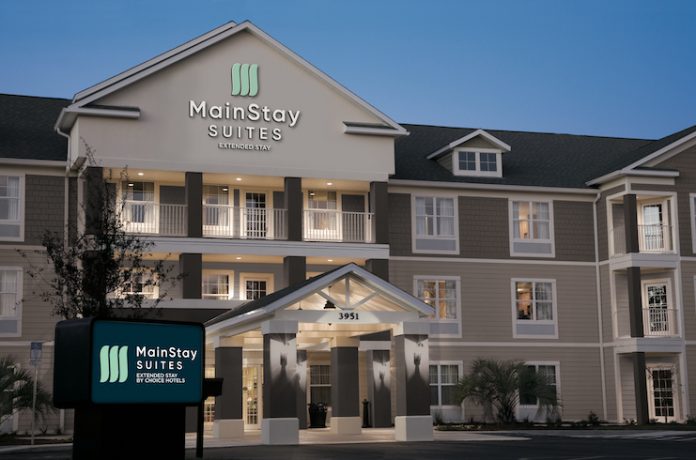According to Ron Burgett, senior vice president, development, extended stay for Choice Hotels, there continues to be plenty of room for growth in the extended-stay market, which proved to be especially durable during the pandemic, partly because it was a low-touch, low-labor, longer-term housing option for essential workers and others who were not subject to stay-at-home orders. In a recent interview with LODGING, Burgett described the growth within this segment, where Choice is branching out through acquisitions and conversions as well as new construction.
Over the past several years, Choice has expanded its new-construction, extended-stay products with the launch of the midscale Everhome Suites brand in 2020 and the acquisition of the economy WoodSpring Suites brand in 2018. But its conversion-focused extended-stay brands—the midscale MainStay Suites and economy Suburban Extended Stay Hotels—are growing; earlier this year, Gulf Coast Hotel Management announced plans for 15 MainStay Suites conversions, growing that brand’s room count by more than 35 percent. Burgett also described how Choice is increasingly converting underperforming economy brands into Suburban Extended Stay Hotels via a “kitchen in a box” solution to provide the facilities that travelers need in longer-stay properties.
What’s your view of the extended-stay market now and going forward?
Convincing people to invest in products designed for stays of 30 days or more used to be a hard sell, but things have changed, especially since the pandemic. Extended-stay occupancy has grown in every one of our segments. Four years ago, our average length of stay at MainStay Suites was four days; it is now 10. WoodSpring Suites, which we’ve had for about three years now, is more than double that. It’s become clear that this is something people want and that this is an undersupplied market—one with 20 percent more demand than supply.
What makes this model so profitable?
Longer-stay guests want a clean, well-appointed room and to be left alone. And the longer guests stay, the more money we make. There are fewer touches with the front desk and rooms aren’t cleaned every day, so they require less staff.
What are the business drivers for the extended stay market?
Right now, about 15 to 20 percent of guests are transient, staying for fewer than five days at MainStay Suites, but there are also plenty of state and contract workers staying for much longer. We’re exploring ways to attract more corporate contract workers for longer stays at a higher price point without adding labor. One example is our grab-and-go marketplace that enables guests to get a sandwich or candy bar without dealing with the front desk. In addition, through new technology, there will be a way to provide more hot and cold options from vending machines, including beer and wine, in addition to the grab and go. We’re not looking at it as a huge revenue generator as much as a neutral break-even to attract mid-market business.
What does the pipeline look like and what are you expecting/projecting for the year ahead?
Contributing to our aggressive growth is one of our strongest pipelines ever—298 active projects—including MBAs (multiunit development agreements) whereby a buyer commits to a specific number of deals in a designated area over a given period of time.
To support this growth as well as the 460 extended-stay products that are open now, we have created what we’re calling the Choice ES division, where we can put resources toward making sure that these properties operate as they were designed to, not just as big rooms. We want people cooking, filling up the fridge, and staying in like a home away from home.
Where is the interest from developers and owners coming from now?
With GOPs consistently in excess of 50 percent, especially at WoodSpring, many of our existing franchisees are coming back to get more of that. We’re also getting some folks that want to diversify their portfolio. So, as much as we would like to bring in new people, most of our business focuses on private equity, funds designated for multiple transactions, which is where we expect to stay and grow.
Can you describe what’s behind the conversion of economy brands into what is now Suburban Extended Stay hotels?
With Suburban, we’re focused on the conversion of economy transient suburban brands to extended-stay hotels. This involves repositioning an unbranded or under-branded property into the extended-stay segment. To make it easy for owners to envision and implement this transformation, we have a module that enables them to put a kitchen in a standard guestroom. It’s like a “room in a box” that can be shipped and positioned behind the bathroom, where the plumbing for the bathroom is already in place. It includes a sink, a full-size refrigerator that plugs into a 110 outlet, and several different options for cooking.
What’s ahead for Everhome Suites—a brand that was introduced at the start of the pandemic?
This higher-end product for guests willing to pay a bit more did have to be put on the back burner in 2020, but I would say we’re roaring back now, helped by a real estate team that makes it a turnkey proposition even for owners without previous hotel experience. Right now, our strongest market has been the four corners of the country—Seattle, New England, South Florida, Atlanta, plus pockets in the middle, including Dallas and Chicago.











